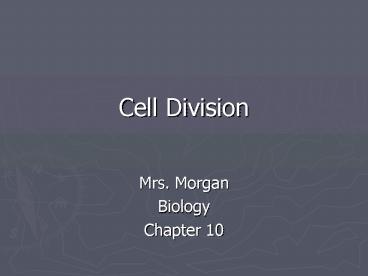Cell Division - PowerPoint PPT Presentation
1 / 19
Title:
Cell Division
Description:
The genetic information is in the form of DNA (DeoxyriboNucleic Acid) ... the time between cell divisions and it can take a very long time when compared ... – PowerPoint PPT presentation
Number of Views:95
Avg rating:3.0/5.0
Title: Cell Division
1
- Cell Division
- Mrs. Morgan
- Biology
- Chapter 10
2
Cell Division
- Cell division is the process where a cell divides
into 2 daughter cells and each daughter cell has
an identical set of chromosomes.
3
Chromosomes
- Chromosomes are the structures within the cell
that contain the genetic information that is
passed on from one generation of cells to the
next. - The genetic information is in the form of DNA
(DeoxyriboNucleic Acid). - Chromosomes are made up of chromatin. During the
early stages of mitosis, chromatin condenses and
the chromosomes become visible. - Chromatin is made up of DNA and protein.
4
Source http//www.damours.iric.ca/Site/Projects.
html
5
Source www.tetrasomy18p.ca
6
The chromosome contains two sister chromatids
(identical parts) which are attached at the
centromere.
Source library.thinkquest.org. Image by
Chemobyl Frog Dissection
7
The Cell Cycle
During the cell cycle, a cell grows, prepares for
division, and divides to form 2 daughter cells,
then both those cells begin the cycle anew.
8
Interphase
- Interphase is the time between cell divisions and
it can take a very long time when compared with
the actual process of cell division. - Interphase is divided into 3 phases, G1, S, and
G2. - G1 is the period of activity in which cellular
growth and development takes place. - Then S phase occurs. S phase is when DNA
replication takes place. - Finally, G2 phase involves the synthesis (making)
of organelles and material necessary for cell
division. - Even though it seems as though the cell is
inactive during Interphase it is actually
involved in intense activity. Proteins are made,
DNA is copied, ATP is made and used.
9
Mitosis
- Mitosis is divided into 4 phases prophase,
metaphase, anaphase, and telophase.
10
Prophase
- Is the longest phase
- Chromosomes become visible because the chromatin
has condensed and coiled up. - Centrioles separate and move to opposite sides of
the nucleus. - The condensed chromosomes become attached to
fibers at the centromere of each chromatid. - Nucleolus disappears and the nuclear envelope
breaks down.
11
Metaphase
- Shortest phase of mitosis.
- The chromosomes line up across the center
(equator) of the cell. - Microtubules connect the centromere of each
chromosome to the poles of the spindle. Because
of their starlike arrangement around the poles of
the spindle, these microtubules are called
asters, which is Greek for star.Source
Biology, Miller Levine, 4th ed.
12
Anaphase
- The third phase.
- Begins when the centromeres that join the sister
chromatids split. This causes the sister
chromatids to separate, becoming individual
chromosomes. - The spindle grows longer.
- The chromosomes continue to move until they have
separated into two groups near the poles of the
spindle.
13
Telophase
- The final phase of mitosis.
- The chromosomes begin to uncoil into a tangle of
chromatin. - The nuclear envelope reforms around the
chromatin, the spindle begins to break apart, and
a nucleolus becomes visible in each daughter
cell. - This is the end of mitosis, but not the end of
cell division.
14
Cytokinesis
- The result of mitosis is that there are two
nuclei, each with a duplicate set of chromosomes. - Cytokinesis, the division of the cytoplasm into
two individual cells, quickly follows mitosis.
15
http//www.cellsalive.com/mitosis.htm
16
Whitefish Cell
17
(No Transcript)
18
Onion root tip
19
Source faculty.clintoncc.suny.edu































